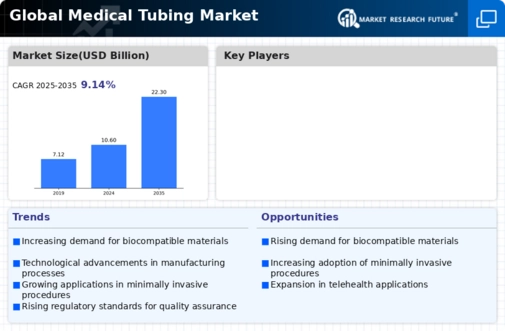Market Trends
Key Emerging Trends in the Medical Tubing Market
The medical tubing market is experiencing several notable trends that are shaping its future and driving its growth. One prominent trend is the increasing demand for minimally invasive surgical procedures. These procedures, which involve smaller incisions and less trauma to the patient, require advanced medical tubing for precise fluid delivery, device insertion, and drainage. As the preference for minimally invasive techniques grows due to their benefits, such as faster recovery times and reduced hospital stays, the demand for specialized medical tubing continues to rise.
Another significant trend is the development of advanced materials for medical tubing. Innovations in materials science are leading to the creation of tubing with enhanced properties, such as greater flexibility, biocompatibility, and chemical resistance. Silicone, thermoplastic elastomers (TPE), and polyvinyl chloride (PVC) are among the materials gaining popularity due to their superior performance in medical applications. The continuous improvement of these materials ensures that medical tubing can meet the stringent requirements of various medical procedures and applications.
The trend towards customized and application-specific medical tubing is also gaining momentum. Medical device manufacturers and healthcare providers are increasingly seeking tubing solutions tailored to specific applications, such as catheters, intravenous therapy, and diagnostic equipment. This customization allows for better performance and efficiency in medical procedures, as the tubing is designed to meet the exact needs of the application. Companies that can offer bespoke tubing solutions are well-positioned to capitalize on this trend.
The integration of antimicrobial and anti-thrombogenic coatings in medical tubing is another important trend. These coatings help reduce the risk of infections and blood clots, which are critical concerns in medical settings. The growing focus on patient safety and infection control drives the demand for tubing with these specialized coatings. As healthcare providers strive to improve patient outcomes and minimize complications, the adoption of antimicrobial and anti-thrombogenic medical tubing is expected to increase.
Sustainability and environmental considerations are becoming increasingly important in the medical tubing market. There is a growing emphasis on developing eco-friendly products and sustainable manufacturing practices. Companies are exploring the use of recyclable and biodegradable materials to reduce their environmental footprint. This trend is driven by regulatory requirements, as well as by the increasing awareness and demand from consumers and healthcare providers for environmentally responsible products.
The expansion of healthcare infrastructure in emerging markets is also a significant trend impacting the medical tubing market. Developing regions, particularly in Asia and Latin America, are investing heavily in healthcare facilities and services to improve accessibility and quality of care. This expansion leads to a higher demand for medical supplies, including tubing. Companies that can establish a presence in these growing markets are likely to see significant growth opportunities.
Technological advancements, such as the incorporation of smart technology into medical tubing, are also shaping the market. Smart tubing can include features like sensors for monitoring fluid flow, pressure, and temperature, providing real-time data to healthcare providers. This innovation enhances the precision and effectiveness of medical treatments, improving patient care. The integration of smart technology into medical devices is expected to drive the demand for advanced medical tubing solutions.
Regulatory changes and compliance requirements continue to influence market trends. The medical industry is subject to stringent regulations to ensure the safety and efficacy of medical products. Companies must stay abreast of changing regulatory landscapes and ensure their products meet the necessary standards. Compliance with these regulations is crucial for market entry and acceptance, and companies that can navigate these requirements effectively will maintain a competitive edge.
Increased investment in research and development (R&D) is another trend in the medical tubing market. Companies are dedicating significant resources to R&D to develop innovative products that meet the evolving needs of the healthcare industry. This investment is leading to the creation of new tubing materials, advanced manufacturing techniques, and improved product features, driving the overall growth of the market.



Leave a Comment